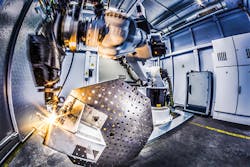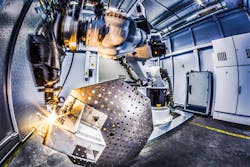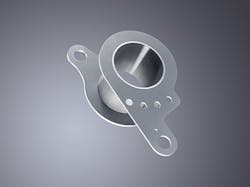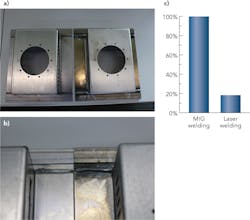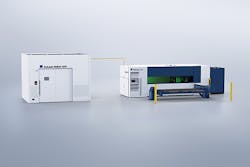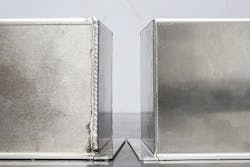Job shops benefit from increased return on investment
PHILIPP RETTENMEIER and BRETT THOMPSON
"If you always do what you always did, you will always get what you always got." At the beginning of 20th century, world-famous physician Albert Einstein recognized that innovation is the result of looking at things differently, and this is true in sheet metal fabrication as well. As the laser became a widespread technology for cutting applications, productivity increased dramatically for job shops looking to compete. However, when joining sheet metal, job shops have yet to fully embrace more of the benefits laser technology affords. For example, most sheet metal parts are still joined by conventional arc welding processes, such as metal inert gas (MIG), metal active gas (MAG), or tungsten inert gas (TIG) welding, and these processes have seen few changes over the last few decades. The majority of conventionally welded parts still require a refinishing step—such as grinding—to achieve perfect quality, yet this additional step could easily be overcome with laser welding. This innovative approach not only opens up completely new markets for job shops, it also makes them more competitive in the global marketplace.
Advantages of laser welding
Laser welding is a thermal process. With high power density and high welding speed, the metal is melted locally by the energy in a laser beam. For sheet metal welding, the laser beam is usually generated by a solid-state laser resonator—for example, a disk laser. Because of the small laser spot size, low total heat input is introduced into the processing zone, which results in reduced component distortion compared to arc welding processes. FIGURE 1 depicts the welding process of a typical sheet metal part within a laser welding cell. Once parameters such as laser power, weld speed, and focal positioning are determined, consistent and high-quality welded joints can be produced and easily repeated. The quality becomes independent of a welder's skill.
By adjusting the aforementioned laser welding process parameters, one can also distinguish between heat-conduction welding and deep-penetration welding. The former creates cosmetic weld seams with smooth surfaces for applications including enclosures, boxes, sinks, and counter segments (FIGURE 2). Deep-penetration welding is used, for example, in manufacturing thicker-section pressure tanks, stiffeners, and flanges (FIGURE 3), where superior weld strength and tight weld seams are required. As proven by more than 100 tensile tests conducted at a materials testing institute in Germany, laser-welded butt joints failed in the base material, rather than the weld joint, without exception. In contrast, tests showed approximately 75% of the TIG-welded joints failed in the weld joint.
Laser welding also allows high flexibility in regard to welding joint geometries. Design aspects of sheet metal parts currently play an increasing role for customers of job shops. Whereas arc welding processes are restrictive concerning part design, laser welding creates new joint possibilities, such as curved corner welds and overlap joints. Even material combinations with different sheet thicknesses are weldable, which facilitates material cost savings and lightweight designs.
Furthermore, production time can be reduced dramatically by laser welding—not only because of increased weld speed, but also through a reduction in secondary operations like grinding and straightening. In this way, production costs can be lowered by up to 60% and the savings continue to increase with volume and batch size. Looking at an electrical housing made of 0.060in. mild steel (FIGURE 4), MIG welding and grinding time takes five minutes in total. Laser welding not only creates better weld seam quality, it also reduces total processing time by more than 80% to 55 seconds without any refinishing at all. Reduced manufacturing times simply enable job shops to be more flexible overall.
Reduced costs through a network
Although there are clear benefits to laser welding, many job shops are deterred by the perceived learning curve and cost of entry. However, the latest advances have made it a more viable solution for the variable needs of a job shop. In addition, the initial investment costs can be reduced by up to 40% when an existing laser resonator from a 2D laser cutting machine is used in a laser network (FIGURE 5). Since the control of either processing station can address the laser, there is technically no need for a central control system in a laser network. Using specific control commands, once one processing station finishes a production task, the laser beam is simply released by that station and made available for the second processing station. The change happens instantaneously, keeping the laser resonator as active as possible. With up to four outputs, the design of the disk laser allows fabricators to share the beam in a more stable and reliable way. Thus, laser power is consistent within ±1% during operation of the disk laser.
Job shops benefit from increased return on investment of the laser welding system as the initial investment costs are significantly reduced when the laser beam is shared between two systems. This advantage is not only restricted to the initial cost of the welding system—increased beam utilization also influences the cost accounting of the laser cutting machine. It is also possible to install a separate laser resonator dedicated to the laser welding system after it has operated successfully for some time. This enables sheet metal fabricators to profit from the aforementioned advantages of laser welding by making a smaller initial investment and allowing it to pave the way for a successful growth later on.
Implementation of a laser network
Werner Neumann, CEO of German job shop CBV Blechbearbeitung (Laasdorf, Germany), invested in a 3kW solid-state disk laser network consisting of the high-productivity 2D TRUMPF TruLaser 5030 fiber and a TruLaser Robot 5020 lasers. Although Neumann was initially concerned about fixture construction and redesign of parts, the ability to enter into laser welding at relatively low investment costs by sharing the beam source was highly appealing.
Before getting started, Neumann sent two welders to TRUMPF for training, intentionally building on their experience in conventional welding. On the day they returned, they were able to transfer a complete customer order—a series that would be repeated several times—to the new robot cell. Since then, CBV has transitioned 20 different parts to this system. While many of these parts have a high piece count, CBV found laser welding to be a worthwhile endeavor for small batches and single-piece production as well.
CBV has many examples of how productivity has increased as a result of laser welding. A batch of 100 parts made of 0.8mm aluminum required approximately 12 hours of finishing work after manual welding. The laser system reduced this to just 90 minutes. Another part featured a 30mm-wide edge that needed to be welded to a crowned housing panel made of 2mm-thick stainless steel (FIGURE 6). Here, the refinishing time was reduced by 90%.
In addition, utilization of the beam source rose from 50% to over 85%. To maximize uptime, CBV operators insert carefully spaced "pauses" in the laser cutting job orders so that every few minutes, the cutting unit comes to a standstill and the robot starts welding. Then, the beam source is diverted back to the fiber.
The company also took advantage of the increased capabilities that laser welding enables. For example, they were struggling to weld electro-galvanized steel sheets manually. CBV welders worked with TRUMPF experts and the Linde Industrial Gas Company to find the correct parameters and the right mix of gases to weld these special containers. Through laser welding, the containers now require almost no refinishing work.
Laser welding offers significant advantages and opportunities for sheet metal fabricators. While investing in new technologies can be intimidating, new innovations enable fabricators to remain competitive long-term. CBV has applied these innovations and, in doing so, successfully demonstrates what Albert Einstein meant all those years ago.
Dr. PHILIPP RETTENMEIER([email protected]) is an R&D & sales engineer and BRETT THOMPSON([email protected]) is a sales engineer, both at TRUMPF, Ditzingen, Germany, and Farmington, CT, respectively; www.us.trumpf.com.
